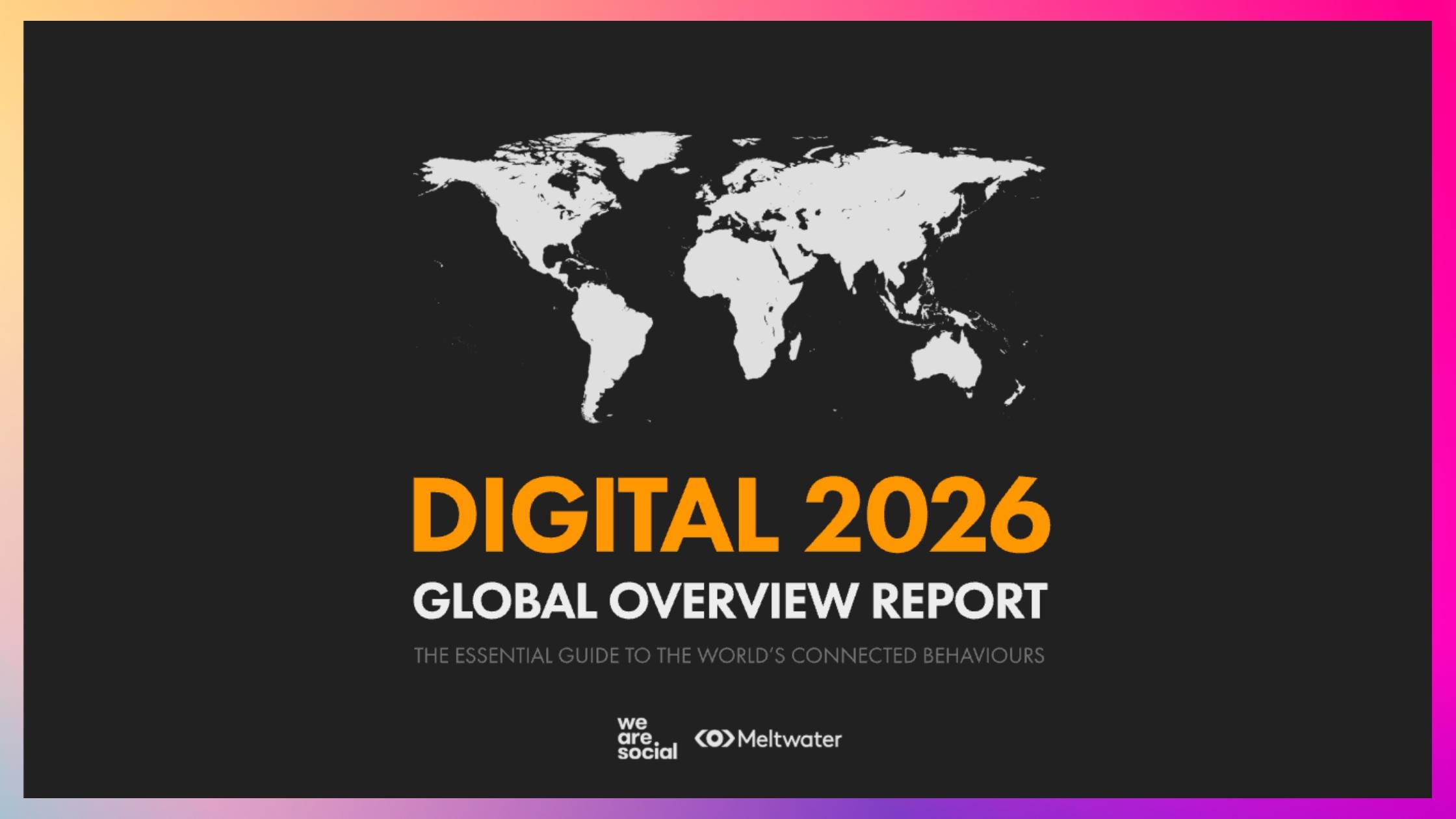In a world where change is the only constant, digital evolution is not about technology only, it’s about the transformation of behavior, expectations, and culture. The Digital 2026 Global Overview Report by We Are Social and Meltwater paints a powerful picture of how people interact, consume, and decide in an increasingly connected world.
Where is Digital Evolving in 2026?
Entering 2026, being online is no longer a choice. It’s the default. In today’s modern civil life, almost everyone is connected to the internet in some way. The number of online and “connected” people continues to grow steadily across all age groups and regions. The internet is not just a utility; it’s the backbone of everyday interactions, decisions, and expressions. The digital landscape is no longer expanding; it’s maturing, fragmenting, and personalizing. From the rise of search-inspired brand discovery to the growing emotional role of social media in daily life, we’re entering a new digital age where convenience meets consciousness, and scale meets specificity.
Here are some powerful signals shaping the digital horizon of 2026:
🔍 Information is still king. The #1 reason people go online? “Finding information” with 60.7% of global users saying this is their primary motivation.
📱 Social and communication platforms dominate digital time. Platforms like WhatsApp, YouTube, and TikTok command not only user time but emotional loyalty.
📺 Video continues to dominate attention. The average daily time spent on TikTok is a staggering 1 hour 37 minutes, followed closely by YouTube at 1 hour 25 minutes.
🌐 Digital isn’t just about screens anymore; it’s about life moments. From how we shop, learn, get inspired, connect, and even discover brands, digital is the default.
But 2026 isn’t just a continuation of the past. It’s a turning point.As privacy reshapes advertising, AI redefines content creation, and platforms evolve from social to semantic, marketers and creators alike must embrace agility, data fluency, and human insight more than ever before. This article explores what’s changing, and what that means, across the key layers of our digital experience: from usage and content to commerce and advertising.
As we decode these patterns, the question isn’t just where digital is heading but whether we’re prepared to move with it.
The Digital Pulse: Global Usage Patterns
The digital heartbeat of 2026 is faster, broader, and more personalized than ever. The trend is not slowing down. It is becoming more embedded in our daily routines, more mobile-driven, and more shaped by personal intent. 6 billion people are now online, with global internet penetration reaching 73.2%. Users spend an average of 6 hours and 40 minutes per day on the internet. With over 5.3 billion internet users globally, digital has evolved from a utility into an extension of human life. It’s not just about being online, it’s about how we use that time and what we prioritize in the online world.According to the latest data, there are now 6.04 billion internet users globally, representing 73.2% of the world population. And user trends, digital behaviors, platform preferences, and content expectations are in constant motion. Trends shift rapidly as users seek more personalized, purposeful, and emotionally relevant experiences across the web.
According to the Digital 2026 Global Overview Report, people go online primarily to:
- Find information (60.7%)
- Stay connected with friends and family (58.7%) Watch videos and TV content (54.2%)
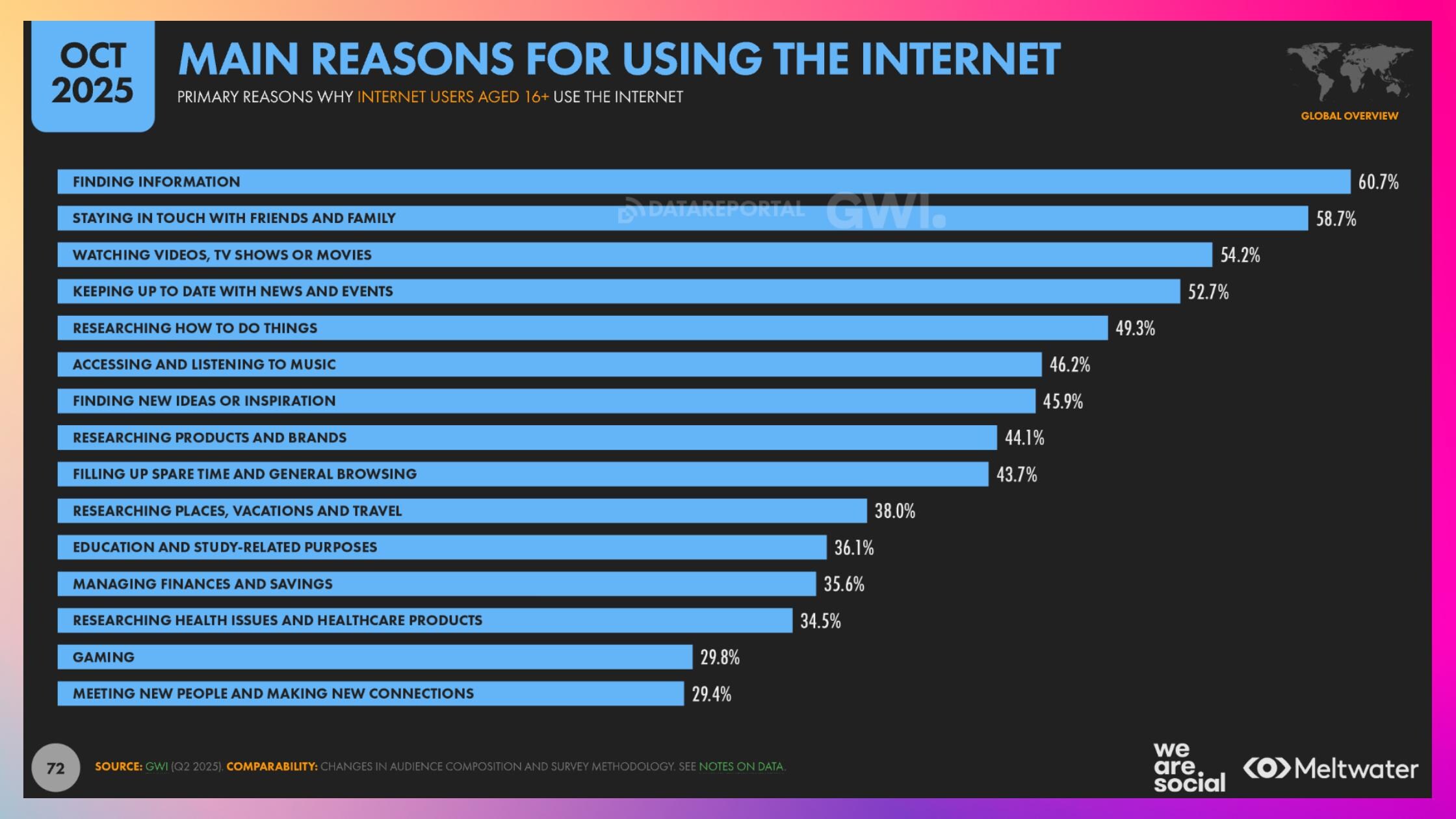
Platforms visited most often include:
- Chat & messaging apps (94.1%)
- Social networks (94.1%)
- Search engines (80.3%)
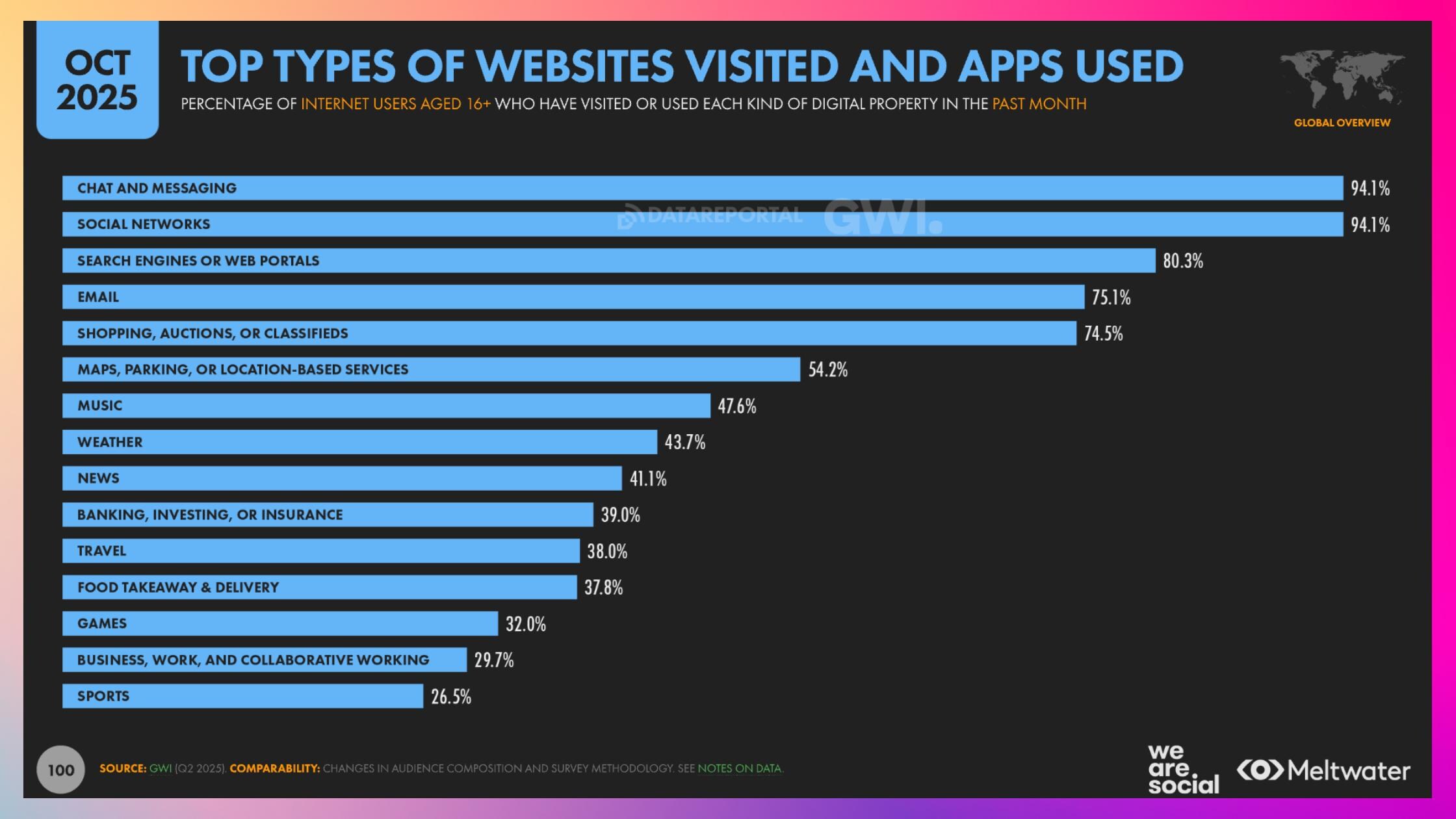
Usage patterns differ by age, but the digital pulse is clear: from Gen Z to Boomers, the internet is where we search, connect, decide, and spend.

In 2026, being online is no longer optional. It’s the core layer of modern life.
Social Media in 2026: Saturation or Evolution?
With almost 5 billion users worldwide, social media has moved beyond being just a digital pastime. It’s now a core layer of human interaction, entertainment, and decision-making. People aren’t just consuming content anymore; they’re seeking connection, context, and credibility.
According to the 2026 Digital Overview Report, the main motivations are:
- Staying in touch with friends and family (50.2%)
- Filling spare time (39.7%)
- Consuming news & content (35.4% and 30.3%)
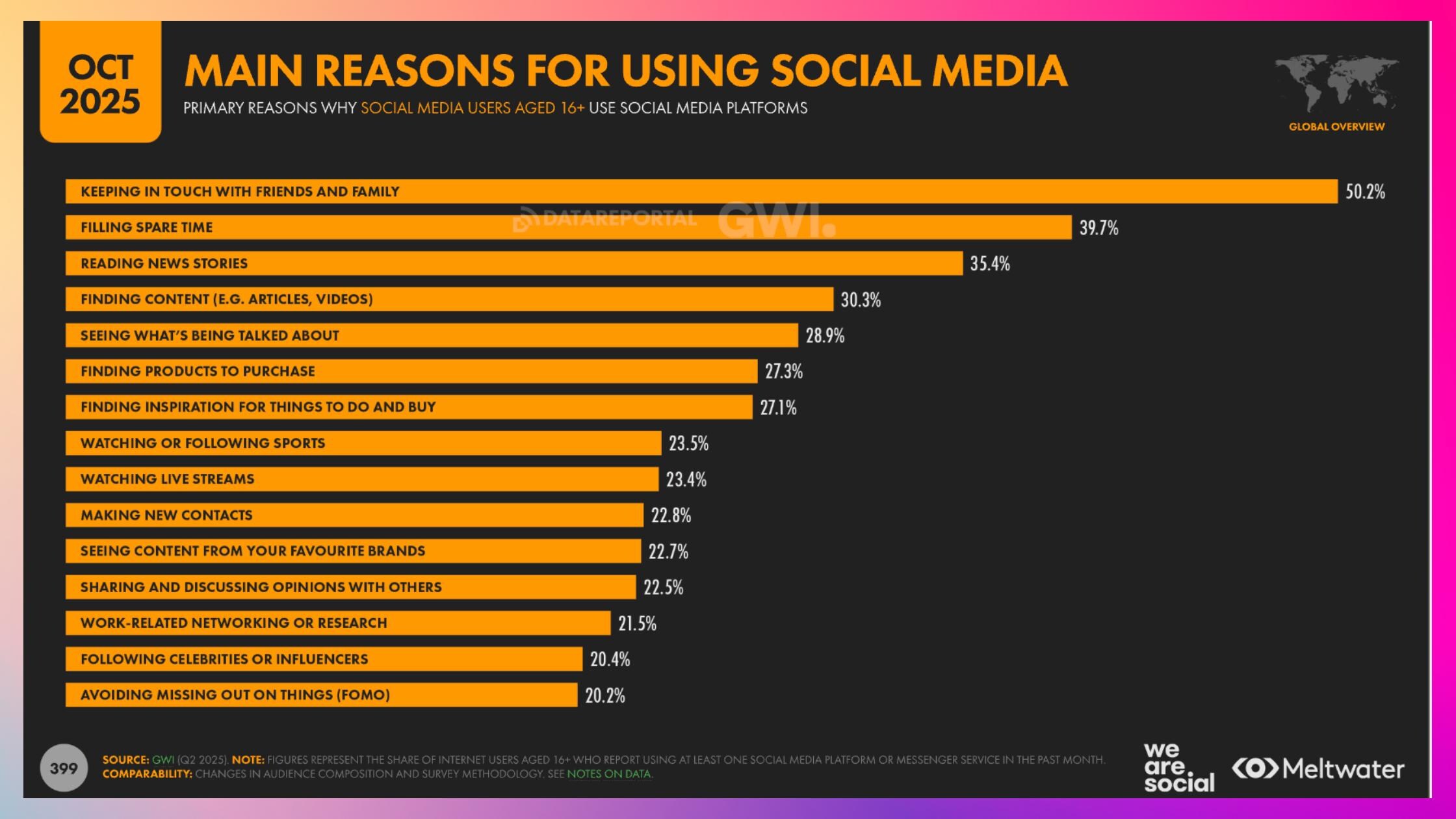
Which platforms lead?
In terms of user preference, WhatsApp (17.4%) tops the list, followed by Instagram (16.4%) and Facebook (13.0%).

These platforms excel at delivering personal connection and visual storytelling — two pillars of sustained engagement.
How long do we stay?
Session durations show where users are truly immersed:
- YouTube leads with an average session time of 14 min 29 sec
- TikTok follows at 9 min 42 sec
- Instagram, X, and Reddit all hover between 4-6 minutes
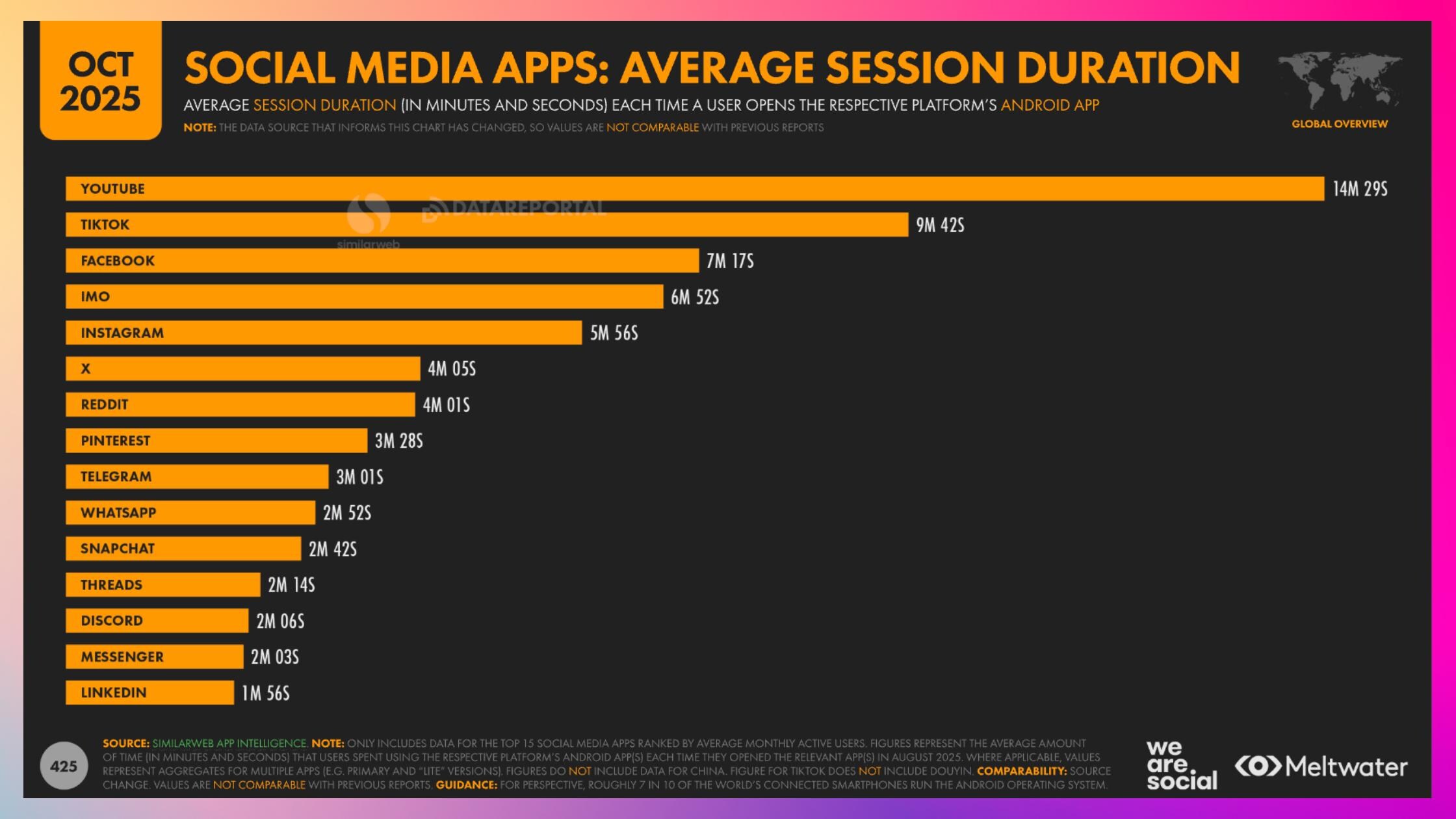
In short: Video-first platforms dominate attention spans, while messaging apps dominate frequency and habit.
So, are we saturated?
Social media in 2026 isn’t hitting a wall. It’s splitting into use-cases:
- Quick, emotional hits on TikTok
- Depth & context on YouTube
- Micro-connection loops via WhatsApp & Instagram DMs
Rather than one-size-fits-all engagement, brands and creators must tailor format to function. It’s no longer about being seen everywhere. It’s about adding value where it matters.
Brand Discovery: What Inspires, What Builds Emotion, What Converts?
In a hyper-connected world, brand discovery no longer happens in silos. It’s emotional, accidental, search-driven, and social: All at once.
🔍 Discovery is Still Search-First
The top source for discovering new brands globally remains search engines (32.9%), followed closely by TV ads (31.8%) and social media ads (30.4%).

This shows that even in 2026, intent-based discovery (search) and exposure-based discovery (ads, word of mouth) work hand-in-hand. Being visible where people are actively looking is still a powerful differentiator.
🔍 Social Media = Research Engine
Social platforms are no longer just for exposure — they’re where buying decisions begin:
- 72.3% of internet users say they use social media to research brands and products.
- Within that, 43.7% turn to social networks like Instagram and Facebook.
- Blogs, forums, microblogs, and vlogs still play a role. Especially in categories that demand depth and trust.

📲 Social Media: Where Emotions Drive Action
Among social platforms, Instagram (62.8%), TikTok (56.2%), and Facebook (53%) lead for brand research.
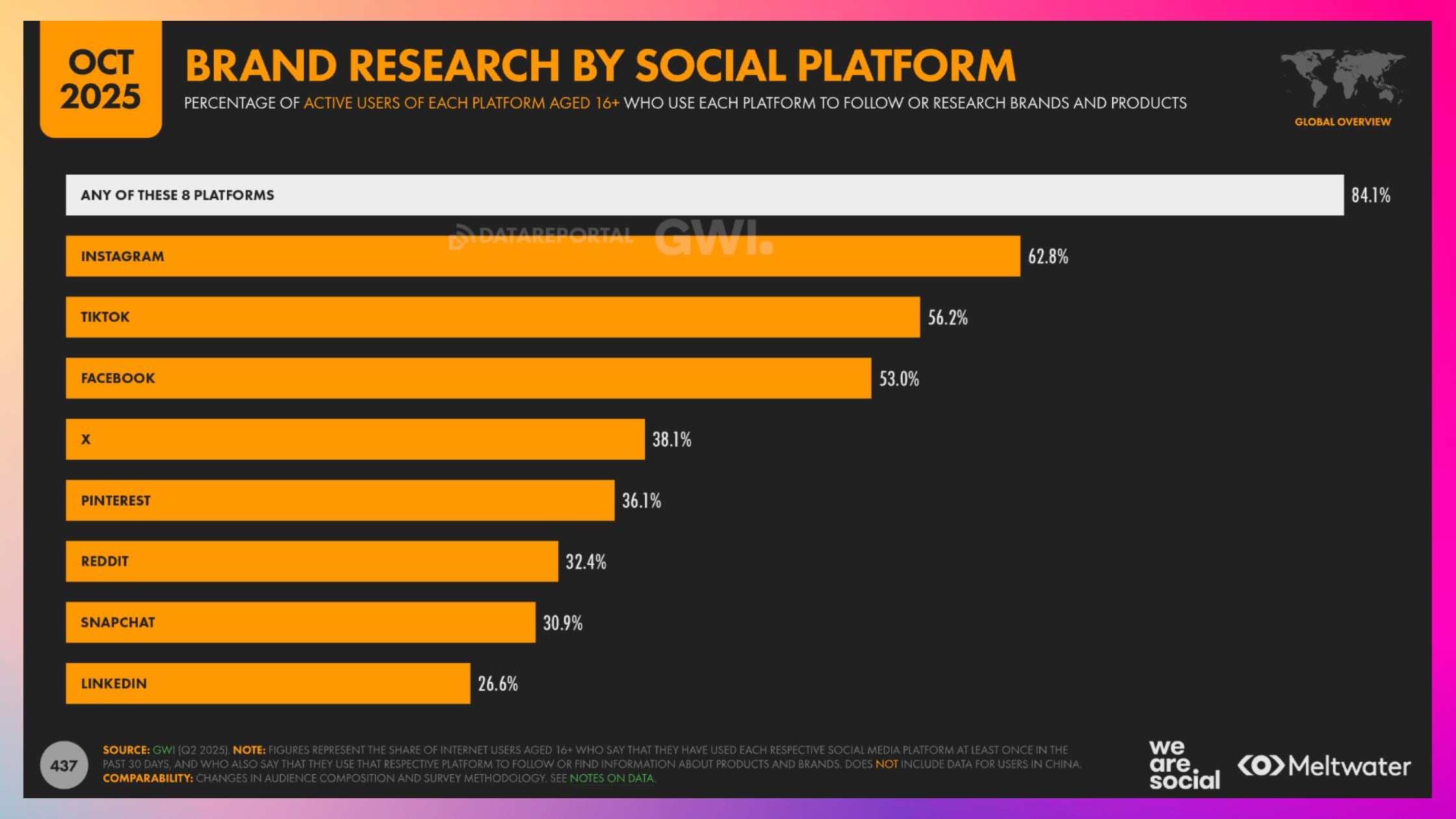
These platforms thrive because they blend lifestyle, visual storytelling, and trust. Making them ideal environments for emotional brand connections.Brand trust is often built on how you show up, not just where you show up.
🤝 Interaction Builds Loyalty
Discovery is only the first step. Conversions begin with brand interaction:
- 43.9% visited a brand’s website
- 25.4% watched a brand video
- 22.9% followed a brand on social media
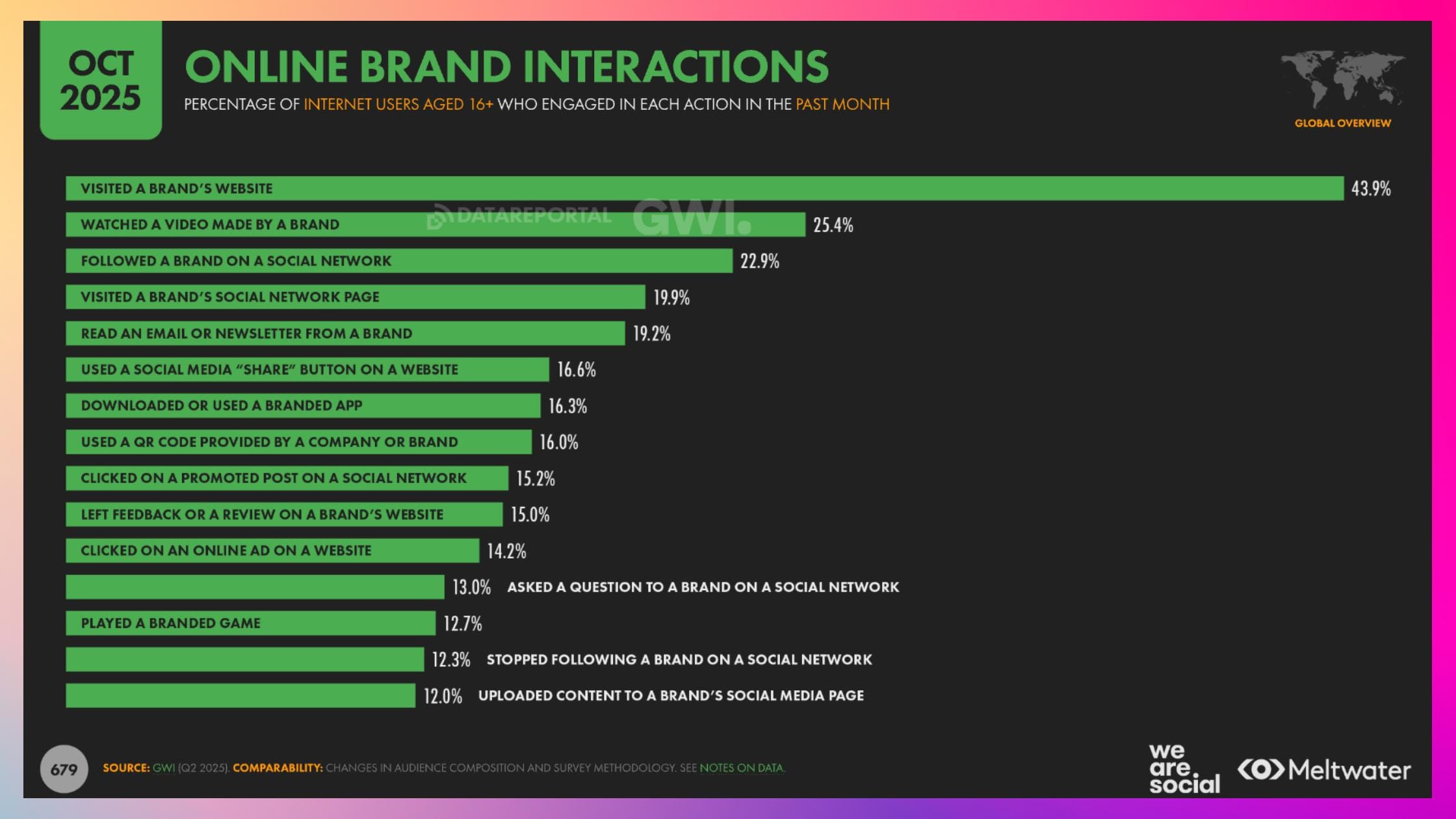
💡 2026 Takeaway
The path to purchase is no longer linear. It’s social, emotional, and fragmented.In 2026, brands that win are the ones that are searched, seen, shared, and believed.
Online Purchasing Behaviours in 2026
In 2026, online shopping is no longer novel, it’s the default. But what makes users click buy has shifted from urgency to ease, trust, and transparency. According to the Digital 2026 Global Overview Report, the most influential online purchase drivers are:
- Free delivery (50.7%)
- Coupons and discounts (38.9%)
- Customer reviews (32.2%)
- Easy return policies (31.7%)
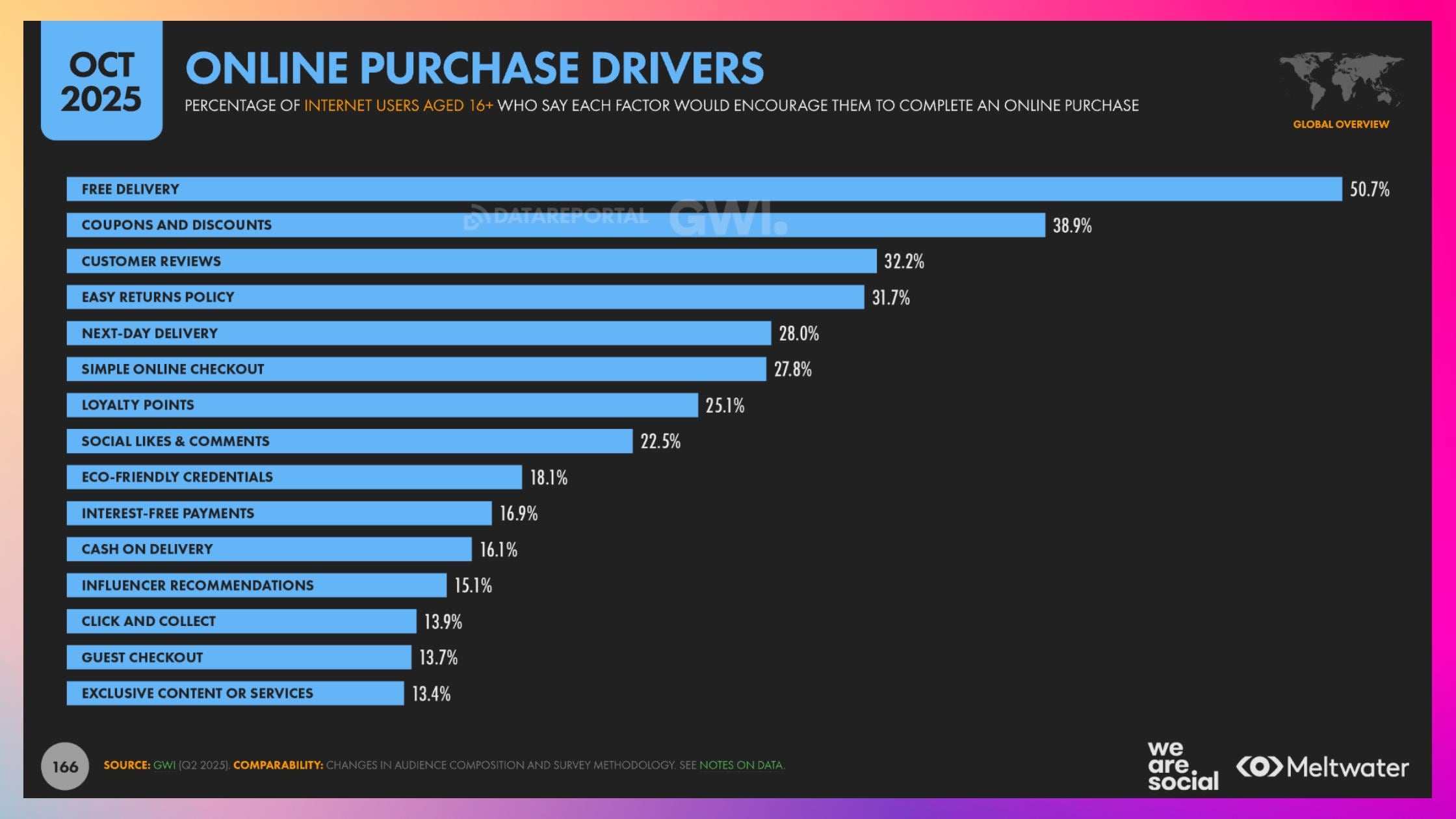
These insights point to a clear trend: convenience and confidence matter more than pressure or persuasion.
🧠 Emotional vs. Practical Triggers
- Fast delivery and simple checkout are no longer differentiators, they’re expectations.
- Social validation (likes/comments) still plays a role (22.5%) but it’s authenticity and practicality that convert.
- Interestingly, eco-friendly credentials (18.1%) and exclusive content/services (13.4%) are rising differentiators, hinting at a more conscious consumer.
What This Means for Marketers & E-commerce Brands
The 2026 shopper is digitally fluent but emotionally selective.To drive conversions:
- Make delivery and returns frictionless
- Highlight reviews and real user content
- Reward loyalty, not just attention
- Align with values (sustainability, accessibility)
In 2026, what wins isn’t urgency. It’s usability + trust.
Digital Advertising: Targeting in a Post-Cookie World
In 2026, digital advertising is bigger, but also smarter. With the phasing out of third-party cookies, advertisers are rethinking not just how much they spend — but how they reach, resonate, and respect privacy.
💸 Spend Keeps Climbing But Fragmenting
Global digital ad spend continues to soar:
- In-app ads lead with $390B
- Online search ads follow at $352B
- Social media ads reached $277B
Influencer ads now represent a significant $39.3B slice
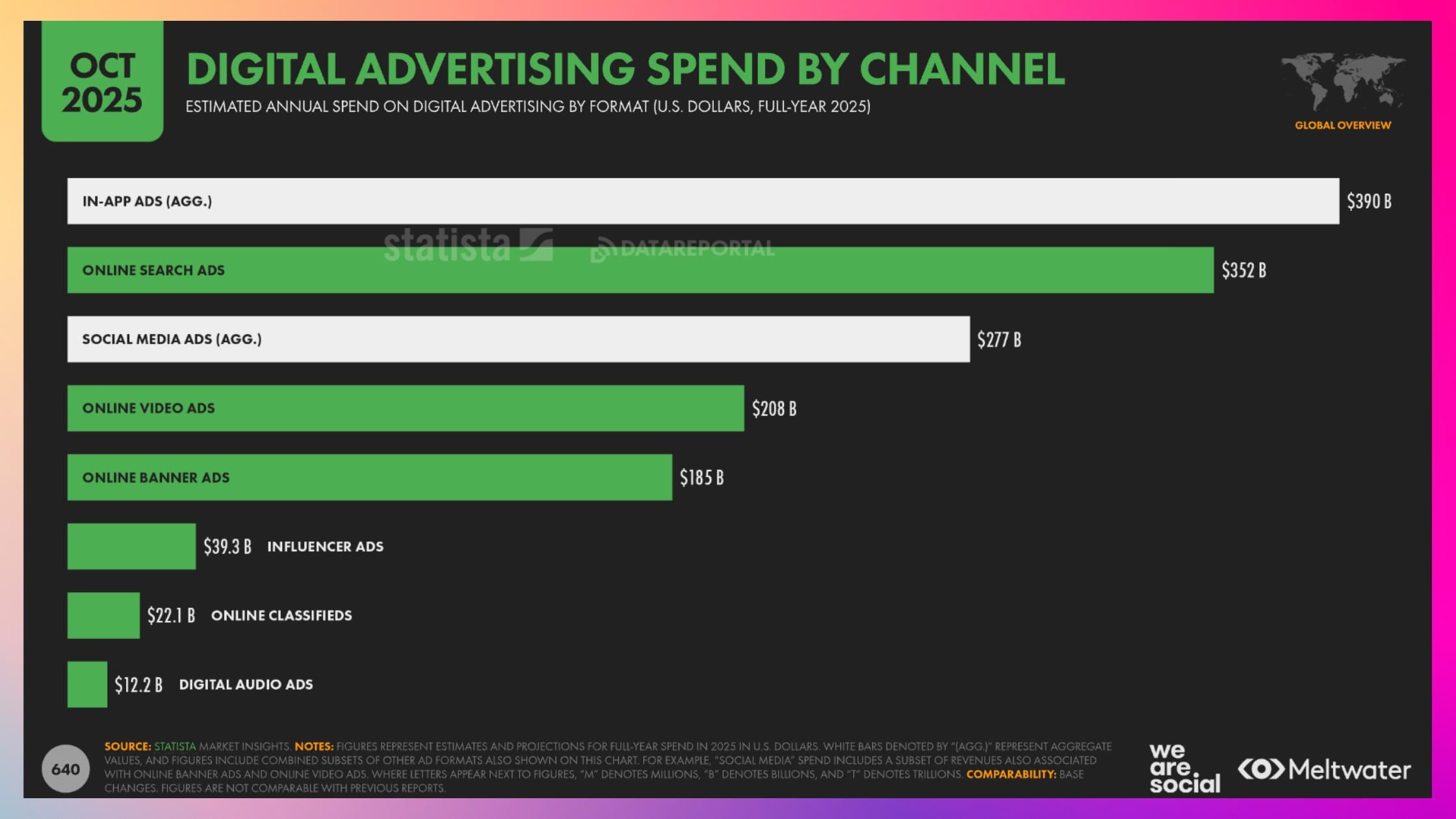
The takeaway? Ad dollars are chasing attention, and that attention is increasingly mobile, visual, and embedded in daily behaviors.
📉 The Cookie Crumbles — What’s Next?
As third-party cookies disappear, advertisers must:
- Leverage first-party data through CRM, email, and owned platforms
- Build contextual relevance, not just behavioral targeting
- Embrace privacy-first frameworks (like Google’s Privacy Sandbox or Apple’s AppTrackingTransparency)
According to the 2026 report, trust is now a performance metric. Users are more aware of how their data is used, and expect transparency.
📱 Social, Video, and In-App Dominate Attention
- Social and video formats have become brand storytelling playgrounds, not just conversion tools
- Online video ads alone account for $208B
- Short-form formats like Reels, Shorts, and TikTok are leading performance
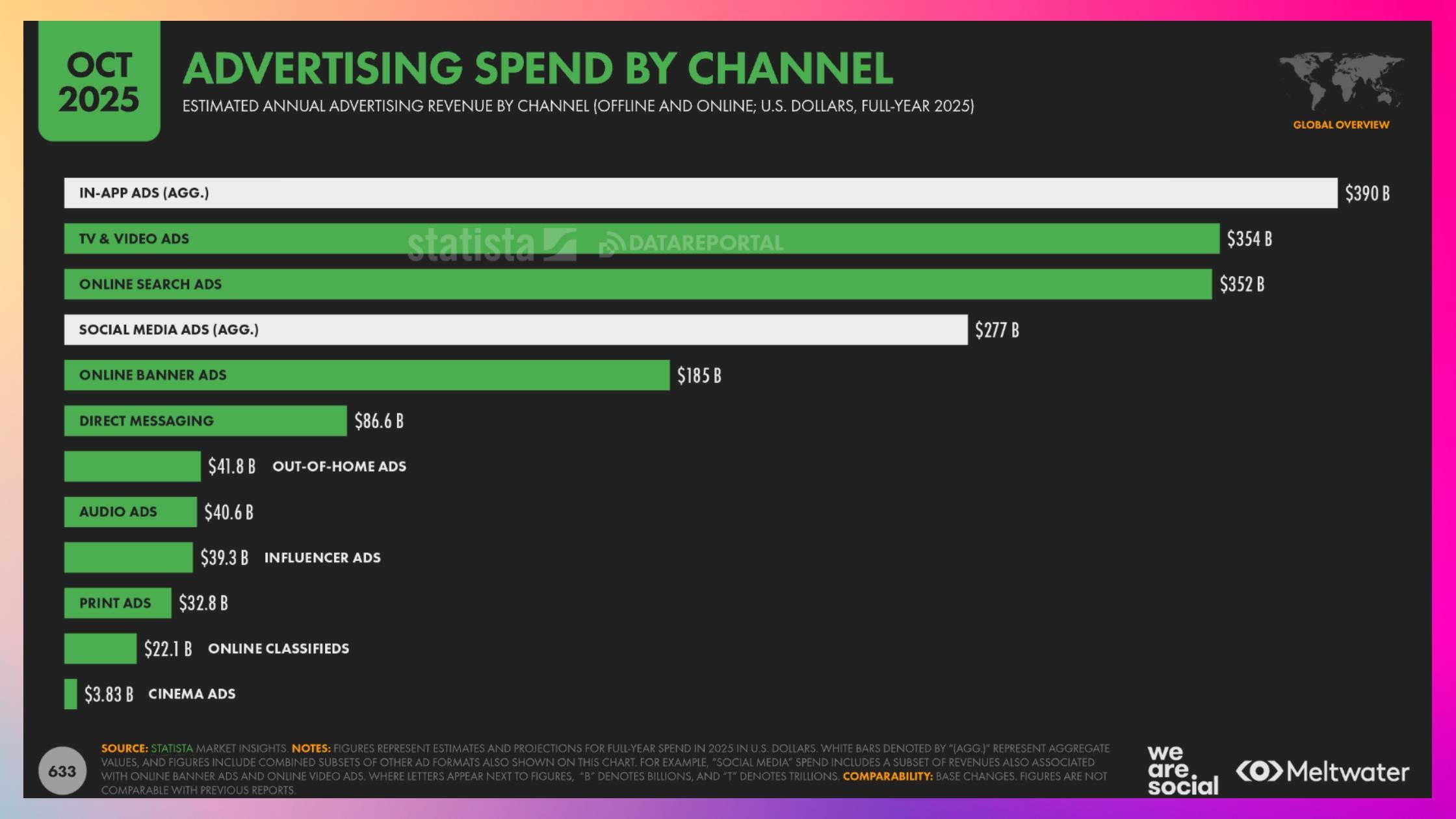
Meanwhile, banner ads still get $185B, showing that legacy formats aren’t dead — they’re just less loved.
🔁 Retargeting Gets Replaced by Relationship
In a post-cookie world, marketers must shift from track & target to earn & engage:
- Build loyalty with value-driven content
- Focus on community, not conversion-first funnels
- Invest in creator partnerships that feel native and human
The future of digital ads isn’t about visibility. It’s about value and voluntary attention.
In 2026, digital advertising remains powerful but it must now be more transparent, more responsible, and more creative. Targeting is being replaced by connection.
What This Means for Digital Marketers, Businesses & Creators
2026 isn’t just another year of trends. It’s a strategic turning point.The digital landscape has matured: more users, more time online, and more platforms than ever. But with that scale comes complexity, and an opportunity for smarter, more human-centered growth.Here’s what it means:
1. For Digital Marketers
- Embrace privacy-first strategies: Post-cookie targeting must be built on trust, consent, and first-party data.
- Shift from “reach” to relevance: Contextual content, storytelling, and values matter more than impressions.
- Leverage creator collaborations, but prioritize authenticity over aesthetics.
2. For Businesses
- Digital is no longer a channel, it’s the core experience layer of your brand.
- Invest in seamless, mobile-first journeys: from discovery to checkout.
- Highlight social proof and transparency, they now convert better than urgency.
3. For Creators
- You’re not just entertainers, you’re influencers of trust and taste.
- Diversify presence across platforms but anchor around a strong community.
- Lean into educational, honest, and story-driven content, that’s what builds emotional connection.
In 2026, winning in digital isn’t about shouting louder. It’s about listening better, showing up smarter, and delivering real value. As digital spaces grow more personal, participatory, and purpose-driven, the brands and creators who thrive will be those who understand nuance, build with integrity, and move with agility. We are entering a decade where technology amplifies empathy, not just efficiency, and where data meets design in service of meaning.
For marketers, businesses, and creators alike, the horizon isn’t just digital, it’s deeply human. And that’s where the true opportunity lies.
You can access the full report via 👉 https://datareportal.com/reports/digital-2026-global-overview-report

